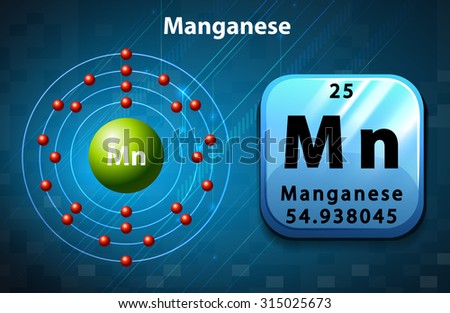ManganeseManganese is a pinkinsh-gray, chemically active element. It is a hard metal and is very brittle. It is hard to melt, but easily oxidized. Manganese is reactive when pure, and as a powder it will burn in oxygen, it reacts with water (it rusts like iron) and dissolves in dilute acids. Applications Manganese is essential to iron and steel production. At present steel making accounts 85% to 90% of the total demand, most of the total demand. Manganese is a key component of low-cost stainless steel formulations and certain widely used alumimum alloys. Manganese dioxide is also used as a catalyst. Manganese is used to decolorize glass and make violet coloured glass. Potassium permanganate is a potent oxidizer and used as a disinfectant. Other compound that find application are Manganese oxide (MnO) and manganese carbonate (MnCO3): the first goes into fertilizers and ceramics, the second is the starting material for making other manganese compounds. Manganese in the environment Manganese is one of the most abundant metals in soils, where it occurs as oxides and hydroxides, and it cycles through its various oxidation states. Manganese occurs principally as pyrolusite (MnO2), and to a lesser extent as rhodochrosite (MnCO3). More than 25 million tonnes are mined every year, representing 5 million tons of the metal, and reserves are estimated to exeed 3 billion tonnes of the metal. The main mining areas for manganese ores are South Africa, Russia, Ukraine, Georgia, Gabon and Australia.
Manganese is an essential element for all species. Some organisms, such as diatoms, molluscs and sponges, accumulate manganese. Fish can have up to 5 ppm and mammals up to 3 ppm in their tissue, although normally they have around 1 ppm. Health effects of manganeseManganese is a very common compound that can be found everywhere on earth. Manganese is one out of three toxic essential trace elements, which means that it is not only necessary for humans to survive, but it is also toxic when too high concentrations are present in a human body. When people do not live up to the recommended daily allowances their health will decrease. But when the uptake is too high health problems will also occur.
The uptake of manganese by humans mainly takes place through food, such as spinach, tea and herbs. The foodstuffs that contain the highest concentrations are grains and rice, soya beans, eggs, nuts, olive oil, green beans and oysters. After absorption in the human body manganese will be transported through the blood to the liver, the kidneys, the pancreas and the endocrine glands.
Manganese effects occur mainly in the respiratory tract and in the brains. Symptoms of manganese poisoning are hallucinations, forgetfulness and nerve damage. Manganese can also cause Parkinson, lung embolism and bronchitis. When men are exposed to manganese for a longer period of time they may become impotent.
A syndrome that is caused by manganese has symptoms such as schizophrenia, dullness, weak muscles, headaches and insomnia.
Because manganese is an essential element for human health shortages of manganese can also cause health effects. These are the following effects:
- Fatness
- Glucose intolerance
- Blood clotting
- Skin problems
- Lowered cholesterol levels
- Skeleton disorders
- Birth defects
- Changes of hair colour
- Neurological symptoms Chronic Manganese poisoning may result from prolonged inhalation of dust and fume. The central nervous system is the chief site of damage from the disease, which may result in permanent disability. Symptoms include languor, sleepiness, weakness, emotional disturbances, spastic gait, recurring leg cramps, and paralysis. A high incidence of pneumonia and other upper respiratory infections has been found in workers exposed to dust or fume of Manganese compounds. Manganese compounds are experimental equivocal tumorigenic agents. |
Environmental effects of manganeseManganese compounds exist naturally in the environment as solids in the soils and small particles in the water. Manganese particles in air are present in dust particles. These usually settle to earth within a few days.
Humans enhance manganese concentrations in the air by industrial activities and through burning fossil fuels. Manganese that derives from human sources can also enter surface water, groundwater and sewage water. Through the application of manganese pesticides, manganese will enter soils.
For animals manganese is an essential component of over thirty-six enzymes that are used for the carbohydrate, protein and fat metabolism. With animals that eat too little manganese interference of normal growth, bone formation and reproduction will occur.
For some animals the lethal dose is quite low, which means they have little chance to survive even smaller doses of manganese when these exceed the essential dose. Manganese substances can cause lung, liver and vascular disturbances, declines in blood pressure, failure in development of animal foetuses and brain damage.
When manganese uptake takes place through the skin it can cause tremors and coordination failures. Finally, laboratory tests with test animals have shown that severe manganese poisoning should even be able to cause tumor development with animals.
In plants manganese ions are transported to the leaves after uptake from soils. When too little manganese can be absorbed from the soil this causes disturbances in plant mechanisms. For instance disturbance of the division of water to hydrogen and oxygen, in which manganese plays an important part.
Manganese can cause both toxicity and deficiency symptoms in plants. When the pH of the soil is low manganese deficiencies are more common.
Highly toxic concentrations of manganese in soils can cause swelling of cell walls, withering of leafs and brown spots on leaves. Deficiencies can also cause these effects. Between toxic concentrations and concentrations that cause deficiencies a small area of concentrations for optimal plant growth can be detected. |
Back to chart periodic elements
|
|

